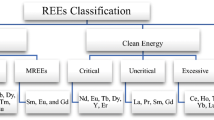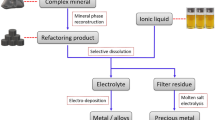Abstract
With the continuous reduction in the availability of extractive metallurgical curricula in colleges and universities, the concern has in part been from where will the next generation of extractive metallurgists come? One objective of this article is to emphasize the fact that extractive metallurgy is, in fact, one of many areas of chemical engineering technology. Thus, although the extractive metallurgist may have disappeared in name, its activity is alive and well, subsumed in the field of chemical engineering. One goal of this lecture is to demonstrate the applicability of chemical engineering principles to what is typically considered “the field of extractive metallurgy.” Two processes will be described that have supplanted typical pyrometallurgical fire refining of precious metals, particularly silver. The origins of fire refining can be traced back to biblical times. There are numerous references to it in the old testament: Ezekiel 22:20, “As men gather silver and bronze and iron and lead and tin into a furnace to blow the fire upon it in order melt it”; Jeremiah 6:29, “The bellows blow fiercely; the lead is consumed by the fire; in vain the refining goes on”; and Malachi 3:2 (The Oxford Annotated Bible with the Apocrypha), “For he is like a refiners fire.” Many references to it will also be found in “De Re Metallurgica” and as well in Lazarus Ercker’s 1574 Manual “Treatise on Ores and Refining.” Today, fire refining has been improved greatly by innovative furnace design, new fluxing technologies, and the improved use of oxygen. However, fundamentally, the process chemistry has not changed much in the last millennium. Illustrations of hydrometallurgical processing of silver-bearing inputs will be provided by the treatment of sulfated silver-bearing materials and chlorinated slimes. The first of these technologies will be described briefly as practiced by the Phelps Dodge Refining Corporation for several years. The second, the treatment of silver chloride-bearing inputs, will be described in detail to demonstrate how typical chemical engineering unit process and unit operations have supplanted classic smelting and fire refining techniques. The Kennecott Copper Company, which has operated a hydrometallurgical circuit successfully for the recovery of high-purity silver from the slimes wet chlorination residue, has permitted me to provide some operation information and results using the technology. Both Phelps Dodge and Kennecott should be recognized for their forward-looking attitude in undertaking the conversion of conceptual chemistry into successful, full-scale plants. The process as employed at Phelps Dodge is discussed at length in reference (J.E. Hoffmann and B. Wesstrom: Hydrometallurgy, 1994, vol. 94, pp. 69–105).








Similar content being viewed by others
Reference
J.E. Hoffmann and B. Wesstrom: Hydrometallurgy, 1994, vol. 94, pp. 69–105.
Author information
Authors and Affiliations
Corresponding author
Additional information
The Extraction and Processing Lecturer Award honors an outstanding scientific leader in the field of nonferrous extractive metallurgy with an invitation to present a comprehensive lecture at the TMS Annual Meeting.
James E. Hoffmann is President of James E. Hoffmann and Associates Company. His academic education includes undergraduate and graduate degrees in chemical engineering. Dr. Hoffmann was employed in extractive metallurgical research by AMAX Corporation and Exxon Minerals Corporation for a total of 29 years. Since 1983, he has provided consulting assistance to the extractive metallurgical industry. His experience includes extensive research in electrolytic refining of copper, nickel, zinc, chromium, manganese, and lead as well as in the process design of numerous electrolytic slimes treatment facilities and precious metals refineries. He is also a specialist in the extraction and refining of rare and precious metals, is the author of numerous papers and patents, and is a member or former member of CIM, AIME, IMM, and IPMI.
Rights and permissions
About this article
Cite this article
Hoffmann, J.E. The Hydrometallurgical Extraction and Recovery of High-Purity Silver. Metall Mater Trans B 43, 431–439 (2012). https://doi.org/10.1007/s11663-011-9624-0
Published:
Issue Date:
DOI: https://doi.org/10.1007/s11663-011-9624-0




